Peaches are a sweet, juicy fruit packed full of nutrition and flavor. They belong to the genus Prunus in the family Rosaceae, which also includes apricots, cherries, nectarines, plums, and almonds. Peaches have been around for thousands of years and treasured by many cultures throughout history. From being part of ancient Chinese medicine to becoming Georgia’s official state fruit in 1995, peaches have made an impact on society all around the world. Here is everything you wanted to know about peaches.
What are Peaches?
Peaches are stone fruit, meaning they have a hard pit or seed in the center surrounded by edible flesh. They typically range from yellow to orange, and their skins can be either smooth or fuzzy. The inside of the peach is usually white-yellowish with a juicy, sweet flavor. Peaches come into season during the late spring and summer months.
History of Peaches
Peaches have been around for centuries and cultivated in China since the early days of civilization. Ancient Chinese medical texts mention peaches as a remedy for several ailments, including indigestion and poor vision. As time went on, traders brought peaches to Europe where they were embraced by many cultures, eventually becoming a popular fruit across the continent.
In the United States, peaches made their way to the country with Spanish explorers and settlers. By the 1800s, they had become an integral part of American culture, especially in Southern states like Georgia, now known as “the peach state.” Today you can find fresh peaches in grocery stores all over the world.
Types of Peaches :
Many peaches vary in size, color, texture, and flavor. Some of the most popular varieties include:
- Clingstone Peaches: They have soft and juicy flesh with a clingy stone or pit inside. They are usually yellow or orange and have a sweet flavor.
- Freestone Peaches: They are easier to remove stone or pit than Clingstones, making them better for canning and baking. Their flesh is usually firmer than Clingstone peaches but still has a sweet taste.
- White Peaches: White peaches typically have pale yellow skin and white flesh. They are sweeter than yellow or orange peaches and have a delicate texture.
Nutritional Value of Peaches:
Peaches are nutritious and delicious fruits full of essential vitamins and minerals. One serving (about two medium-sized peaches) contains over 10% of the recommended daily value for vitamin C, potassium, and dietary fiber. They also contain trace amounts of other vitamins like B6, A, E, and K. Peaches are low in fat and calories, making them an ideal snack or addition to any healthy diet.
Health Benefits of Peaches:
Peaches can provide numerous health benefits due to their high levels of antioxidants, vitamins, and minerals. Studies have shown that eating peaches regularly can help reduce the risk of certain diseases such as cancer, heart disease, and diabetes. They can also help improve digestion, boost the immune system and provide an energy boost due to their high levels of natural sugars.
Uses of Peaches:
Peaches are often eaten as a snack, in salads, desserts, or baked goods. They can also be canned and used in jams, jellies, and preserves. Peaches can provide essential vitamins and minerals such as vitamin A, potassium, iron, and magnesium. Additionally, peaches can be juiced to make refreshing smoothies or tea infusions. Peach skins can also be dried and used for medicinal purposes. Finally, peach pits contain oil many people use for skin care products like moisturizers and lip balms. As you can see, there are many uses for peaches.
How to Plant Peaches?
Planting peach trees is relatively easy, but it does require careful preparation and attention to detail. Following the steps outlined in this guide, you will have a beautiful, productive peach tree growing in your garden that will provide you with juicy, delicious fruit for years to come.
Choose a Site:
When selecting the location of your peach tree, the most important factor is sunlight. Peach trees require at least 8 hours of direct sunlight per day, so choose an area with plenty of sunlight throughout the day. It should also be protected from strong winds as much as possible. Ensure the soil drains well and is rich in organic matter like compost or manure. If you are still determining the quality of your soil, you can have it tested at a local nursery.
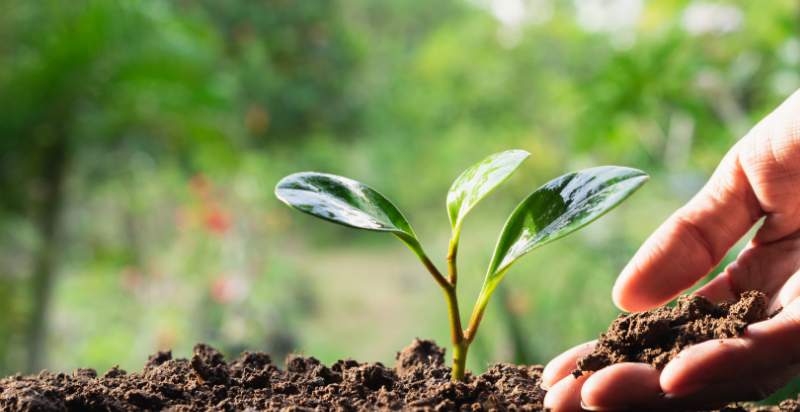
Gather Supplies:
Before you begin planting, ensure you have all the necessary supplies. You will need a container to hold the peach tree (a 3 or 5-gallon bucket is best), soil, compost or manure, fertilizer, and mulch. You may also want to buy a stake to support the tree if it is tall or top-heavy with fruit.
Prepare the Soil:
Once your supplies and site are prepared, it’s time to start planting! Begin by digging a hole twice as wide and twice as deep as the container of your peach tree. Fill the bottom of the hole with soil and then add compost or manure. Mix the soil and organic matter before adding it back into the hole. This will give your new tree a good foundation and ensure it has plenty of nutrients to grow.
Planting Your Tree:
Now that everything is ready, you can finally plant your peach tree! Remove the tree from its container and inspect it for any signs of damage or disease. If all looks good, place it in the prepared hole and fill it with the remaining soil/organic matter mixture. Firmly press down on the soil to ensure no air pockets around the roots. Finally, water thoroughly to help settle the soil and remove any remaining air pockets.
Caring For Your Tree:
Once your peach tree is planted and watered, you must give it the proper care to ensure a healthy, productive crop. Water every few days during dry periods and fertilize once or twice a year in the spring with a balanced fertilizer such as 10-10-10. Apply mulch around the tree’s base to help retain moisture and protect against weeds. Be sure to prune the tree to remain healthy and disease-free regularly.
By following these steps, you can have a beautiful, productive peach tree growing in your garden in no time! Enjoy picking fresh, juicy peaches from your tree for years to come. You will surely have a successful harvest with some dedication and proper care.
How to Care for and Grow a Peach Tree?
Peach trees require regular pruning to maintain their shape and size. Prune the tree each year in late winter or early spring, removing dead, diseased, or weak branches. Thin out overcrowded branches if necessary to allow more light and air circulation throughout the tree canopy.
It is important to keep your peach tree watered regularly. Letting the soil dry out too much can cause a decrease in fruit production and even the death of the plant. Aim for an inch of water per week from rainfall or irrigation during hot weather. Monitor your peach tree at least once a week during drought periods and water accordingly.
Fertilize your peach tree 2-3 times a year with a balanced fertilizer such as 10-10-10. Follow the directions on the package for appropriate application rates. If you notice any signs of nitrogen deficiency, such as yellowing foliage, applying a nitrogen fertilizer will help correct this problem.
Peach trees are susceptible to various pests and diseases, such as aphids, scale insects, and powdery mildew. Monitor your tree regularly for any signs of damage or disease. Consult with your local cooperative extension office or garden center for advice on treatment options if necessary.
Finally, it is important to harvest peaches at their peak ripeness to maximize flavor and sweetness. Pick the fruit when it has reached its full size and is soft enough to remove it from the stem with a gentle twist easily. Eat your peaches as soon as possible and store any leftovers in the refrigerator for up to a week.
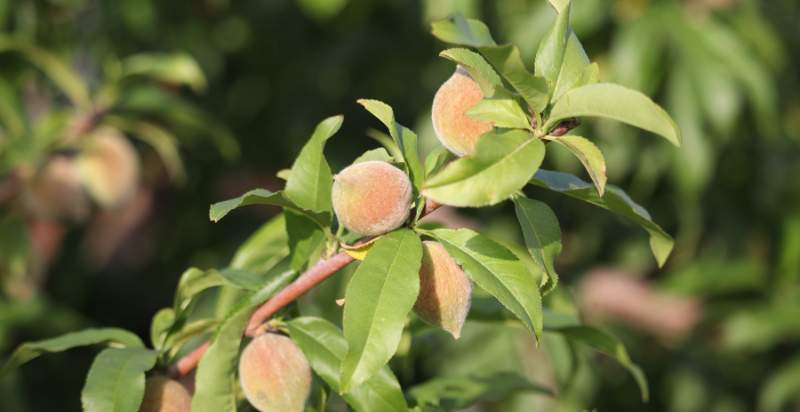
Preventions from Pests and Diseases:
It is important to practice good cultural practices to prevent pests and diseases from affecting your peach tree. Plant your peach tree in a location with full sun exposure and well-drained soil. Avoid planting near trees or shrubs of other fruit varieties, as this can increase the risk of pest and disease spread.
Sanitation is also key in preventing problems in your peach tree. Remove fallen fruit from the ground around the tree and rake up any leaves or debris harboring insects or diseases. Prune away any dead or diseased branches whenever they appear to help stop the spread of these issues throughout the canopy of the tree.
Finally, monitor your tree regularly for any signs of pests or diseases. If you spot something, consult with your local cooperative extension office or garden center for advice on treatment options as soon as possible.
Following these steps, your peach tree can grow strong and healthy in no time! Enjoy the sweet taste of freshly harvested peaches from your backyard all summer.
How to Harvest Peach Trees?
Harvesting peaches can be a tricky job and requires some patience. For the best results, pick your peach fruits when they are fully ripe. The skin should feel smooth and soft, with a deep yellow-orange hue. Pick the fruit carefully so that you don’t damage it or leave any bruises.
Try tasting one if you have difficulty determining if a peach is ripe! A perfectly ripened peach will be sweet and juicy but not mushy. If it tastes sour or has a grainy texture, wait another day before picking it up again.
When harvesting peaches from trees, clippers or pruners can snip off the stem without damaging the fruit; for ground-growing peach trees, pick the fruit directly from the branch. Gently roll it off into your hand without pulling or twisting the stem.
If you’re harvesting to preserve peaches for later, try using a razor blade or sharp knife and make a shallow cut around the fruit’s stem. This will ensure that the skin does not tear when removing it from the tree. Once you have picked all of your ripe peaches, please place them in a single layer on a flat surface like newspaper and allow them to air-dry for several hours before transferring them to a container. This will help prevent bacteria from forming on their skins.
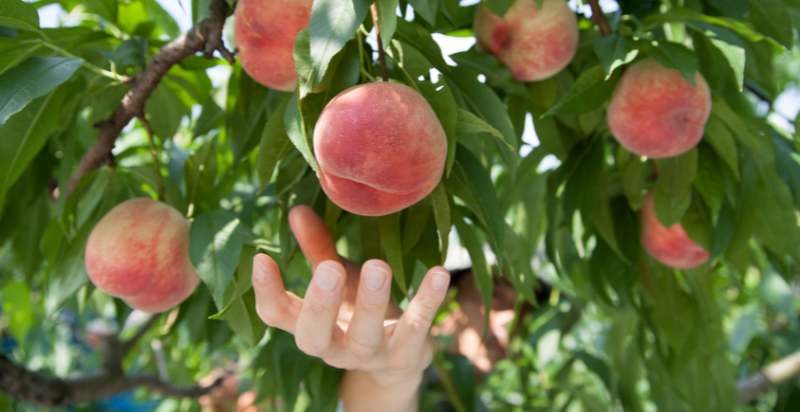
How to Store Homegrown Peaches?
The best way to store homegrown peaches is in the refrigerator. Please place them in a single layer on a plate or shallow container, and cover them with plastic wrap or in an airtight container. Keep them away from other fruits and vegetables as they can easily pick up odors from other produce.
Peaches will last for several days when stored this way. If you need to store peaches for longer, it is best to freeze them. Slice the peaches into wedges or chunks and place on a parchment-lined baking sheet, and freeze overnight. Once frozen, transfer to an airtight container or freezer bag and store for up to 4 months. When ready to use, thaw at room temperature before enjoying!
Another option is to can homegrown peaches. This method involves boiling the peaches and putting them in hot, sterilized jars before sealing them with a lid. Canned peaches should be stored in a cool, dark place for up to 12 months.
No matter which storage method you choose, ensure your homegrown peaches are ripe and free from any blemishes or bruises before storing them to ensure optimal taste and texture.
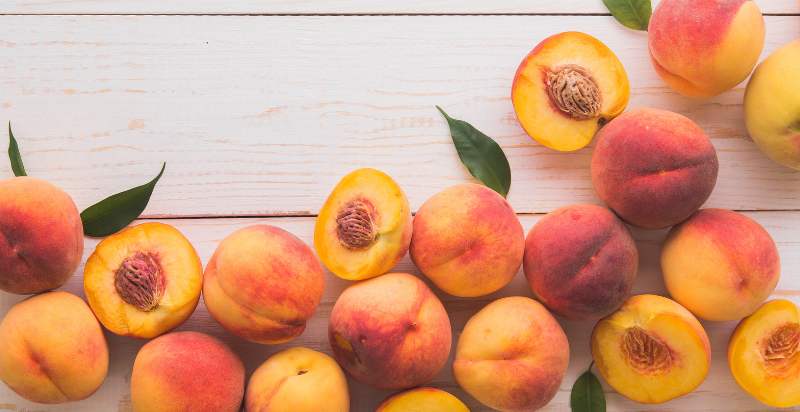
How to Use Peaches?
Peaches can be used in various ways, both sweet and savory. They can be eaten fresh out of hand, pureed into a smoothie or sauce, or cooked in pies and cobblers. Peaches are delightful when grilled or roasted with pork or poultry dishes like chicken wings, kebabs, pork roast, and more. They also pair well with cheeses such as Brie, goat cheese, and blue cheese. Enjoy peaches by adding them to salads for extra sweetness or baking them into muffins or quick bread for a delicious breakfast treat.
Peaches can also be poached in sugar syrup for an indulgent dessert. Peaches are sure to add bright flavor and texture, no matter how you enjoy them – sliced up over cereal or ice cream, frozen into a popsicle, or cooked as part of a dish.
Remember that you can also preserve peaches for later use. Dried peaches make an excellent snack, but they can also be reconstituted by adding water or used in baking recipes like pies and cobblers. Peaches can also be canned or frozen for year-round enjoyment. Enjoy the fresh taste of summer any time of year with preserved peaches!
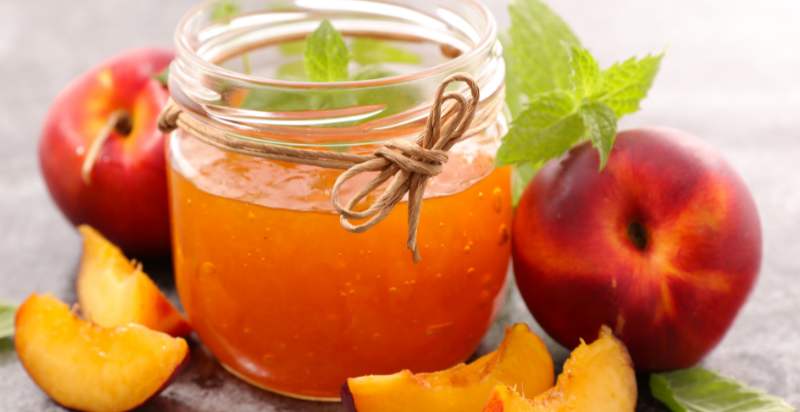
Potential Risks from Peaches:
Peaches can contain toxins from sprayed pesticides or contaminated soil, so it’s important to research the source of your homegrown peaches before consuming them. As with any fruit, foodborne illness is risky if not properly handled and stored. Please wash your hands thoroughly before and after handling peaches, and wash them and wipe away any dirt or debris that may be present.
Additionally, some people may have an allergic reaction to eating raw peaches due to their high levels of histamines. If you experience any adverse reactions like skin rash, difficulty breathing, or swelling of the throat or mouth after eating raw peaches, seek medical attention immediately.
It’s also important to note that although peach pits can be eaten, they should not be consumed in large quantities. Eating too many peach pits can lead to cyanide poisoning and other serious health risks. It is best to avoid eating the pits altogether.
By following these safety tips, you can enjoy homegrown peaches with confidence!
Conclusion:
Homegrown peaches are a delicious and nutritious addition to any diet. They are easy to grow and can be stored in various ways, including freezing, canning, or drying. Peaches can be used in sweet and savory dishes and make a great snack on their own! However, taking proper safety precautions when handling and consuming homegrown peaches is important due to potential risks from toxins or foodborne illnesses. With these tips in mind, you can enjoy homegrown peaches with peace of mind!
Enjoying homegrown peaches is a great way to experience the delicious taste of summer all year round! Proper storage and handling techniques allow you to preserve their fresh flavor and enjoy them whenever the mood strikes. So get out there and enjoy your homegrown peaches – they’re sure to make any meal more special!
- Water Berries: Description, Flavor, Benefits, And Uses - June 18, 2024
- Everything You Wanted To Know About Sweetheart Cherries - June 17, 2024
- Indian Jujube: Description, Flavor, Benefits, And Uses - April 30, 2024

16 thoughts on “Peach Trees: Planting, Growing, and Harvesting Peaches”
Comments are closed.